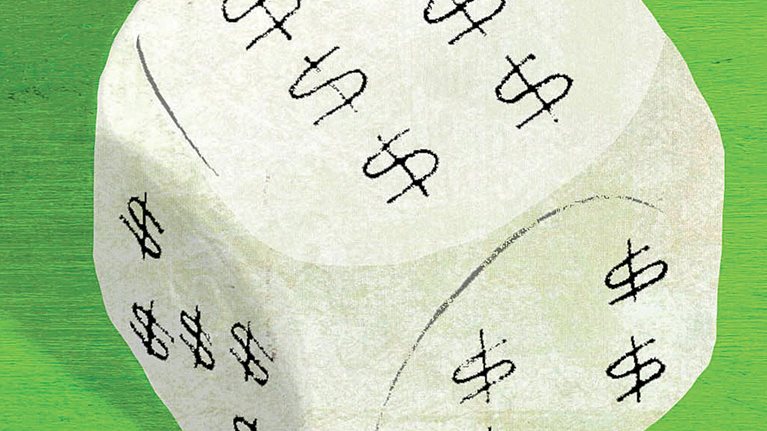The burgeoning excess cash reserves of US companies continue to provoke debate among economists, investors, and legislators. By our reckoning, the 500 largest US nonfinancial companies have now accumulated around $1 trillion more than their businesses need. The majority of this is held offshore, in non-US overseas subsidiaries, to avoid the incremental US income taxes they would pay if they repatriated the money under current US laws.1
Stay current on your favorite topics
All this excess cash is not good for the economy, since it isn’t being used productively. It can tempt companies to make acquisitions or other capital investments that could even destroy value. And it also creates distortions in the economy, compelling investors in these companies, in effect, to hold cash positions in their portfolios that they may not want. When investors bought a share of Apple for $156 on May 12 of this year, for example, they were investing $107 in Apple’s operations, and $49 in Apple’s cash.
The debate over changing US tax law to encourage repatriating the cash revolves around how much productive investment bringing the cash home would create. To inform the discussion, it can help to understand a few practical details about who exactly holds the bulk of this cash, and what they might do with it if they brought it back to the United States. The bottom line: initially, most of the repatriated cash would likely end up going to shareholders in the form of share buybacks or special dividends, rather than in the form of investment in factories and equipment. Nonetheless, bringing it home is still healthier than letting it sit overseas.
Most discussions about how much cash could be brought home focus on a marquee number of anywhere between $1.5 trillion and $2.5 trillion of untaxed profits—depending on whether banks and other financial companies are included. But that’s only a starting point for our calculation. We’ve excluded banks because it’s hard to say from the outside how much cash they’re required to hold by regulation. And we’ve adjusted for the portion of profits of nonfinancial companies that has already been reinvested outside the United States. What’s relevant is how much of the cash held by US-based multinationals could easily be repatriated. Our analysis of the balance sheets of the 500 largest US-based nonfinancial companies confirmed that they had a combined market capitalization of $17.9 trillion at the end of 2016 and revenues of $8.9 trillion. Their $1.66 trillion reserves in cash and near-cash investments amounted to around 10 percent of their total market capitalization and nearly 20 percent of their revenues. And while companies do need to hold some cash to do business, in the past we’ve found that companies can typically do with cash balances of less than 2 percent of revenues. Conservatively, we estimate that about $1.5 trillion of the total cash is above the 2 percent threshold. That’s how much cash companies are holding beyond what finance theory tells us is necessary—but it still doesn’t tell us how much could be repatriated.
Would you like to learn more about our Strategy & Corporate Finance Practice?
That’s because the marquee number also overlooks the highly concentrated distribution of cash across companies and industries. We estimate that about a third of overseas cash is widely dispersed across companies that operate (or earn their profits) primarily in the United States (or where their operations make it difficult to estimate their unrepatriated earnings.) The remaining $1 trillion is held by companies that operate globally and that hold cash outside the United States as unrepatriated profits. That’s the amount that could be brought back to the United States under tax-reform proposals that include provisions, as most do, to substantially reduce the tax obligation.
Some of that cash could be used to reduce US-based debt, it’s true. But if the main objective is that companies will bring it back to reinvest in new factories and equipment, the objective of past tax holidays, there’s another fact often lost in the shuffle. The companies holding more than 90 percent of that $1 trillion don’t have much need for more factories and equipment, with the bulk of it, $700 billion, held by just ten multinational companies in two industries: technology and pharmaceuticals (exhibit). These companies earn very high returns on capital—more than 30 percent after tax2 —and most of them have modest growth.

The amount of investment any company needs to reinvest to sustain growth can be calculated as expected growth divided by return on capital. Most large pharmaceutical companies, for example, are expected to grow revenue less than 5 percent a year and would only need to invest less than about 15 percent of the profits back in the business to continue growing at that pace. The other 85 percent or so would normally be returned to shareholders3 unless the company has attractive acquisition opportunities. The same holds true for the large technology companies. Although some are expected to grow faster, they also have higher returns on capital. This forward view is consistent with their recent behavior.

Paying back your shareholders
So if all the offshore cash of these companies were suddenly repatriated without tax, it would likely be returned to shareholders. Indeed, this is what happened in 2004, the last time offshore cash repatriation was permitted with a lower tax rate: the vast majority of it was returned to investors as share buybacks. And as long as excess cash continues to accrue—for each year they generate much more cash than they can reinvest—companies inevitably have few other options.
Returning cash to shareholders, in fact, would be better for investors and the economy than if the companies themselves attempted to invest $1 trillion rapidly in new plants and equipment. Access to capital has not been a constraint on growth for these companies. Furthermore, these companies are already spending large amounts on R&D. For example, pharma companies typically already spend 15 to 20 percent of revenues on R&D.
Economists can debate where the money will end up if distributed to shareholders—whether it will simply spur demand for shares or make its way to other companies that do have investment opportunities. Even if it’s reinvested by US investors in non-US companies, it increases the returns coming back to the United States. In any case, bringing the cash home is better than leaving it sit.


